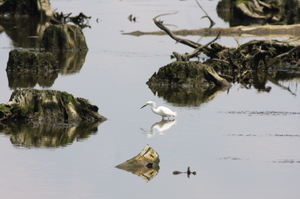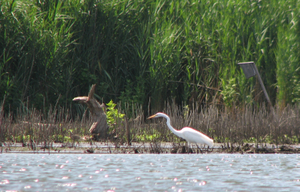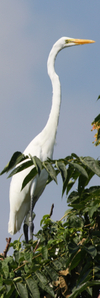The Meadowlands Commission hosted a press conference on the Harbor Herons Project today, featuring speakers from New York City Audubon and the New Jersey Audubon Society talking about the preliminary findings from this summer’s research.
Click "Continue reading" to learn more.
Click here for all Harbor Herons posts.
The data so far show that North Jersey is a crucial feeding ground for egrets that nest in colonies in New York City.
The study, part of the Audubons’ ongoing Harbor Herons Project, was assisted and sponsored by the New Jersey Meadowlands Commission.
With the help of 50 volunteer citizen scientists in New Jersey, the two non-profit groups have been tracking egrets that nest on the East River and near Staten Island, in an effort to see where and how these birds forage for food in
This year’s research found that several locations in the Meadowlands were prime spots for the egrets to feed and hang out during the day.
egrets to feed and hang out during the day.
Snowy egrets, for example, seem particularly drawn to two sites in Secaucus – the Secaucus High School Marsh and Mill Creek Marsh.
Great Egrets favor the fresh-water and brackish marshes in Kearny,
 Both species of egrets, along with Great Blue Herons and other herons, can be readily seen in wetlands throughout the region from April through October.
Both species of egrets, along with Great Blue Herons and other herons, can be readily seen in wetlands throughout the region from April through October.
The New Jersey Audubon Society played the key role this year, training the volunteers and coordinating this huge effort.
According to Nellie Tsipoura, the NJAS director of citizen science, the volunteers also record data on tides and habitat and how they relate to bird use, contributing crucial information that can be used to make decisions on creating new habitats through restoration, controlling water levels at impoundments, and managing the Meadowlands Distric t for the right mix of conditions for these birds.
t for the right mix of conditions for these birds.
As part of the study, researchers banded several birds and put transmitters on 17 Great Egrets in an effort to keep track of their travels.
Some of those birds have been seen in the Meadowlands, and a Great Egret’s radio signals have been picked up in Lyndhurst and North Arlington
In all, volunteers regularly have been monitoring sites in Ridgefield, Secaucus, Lyndhurst, North Arlington and Kearny
This year’s site surveys conclude at the end of October, with a conference on the study planned for December.


Great to see that the NJMC is helping this noble project. This is remains an important agency supporting environmentally valuable work.
All the best to the Audubon scientists and what they’re doing. Great organization.